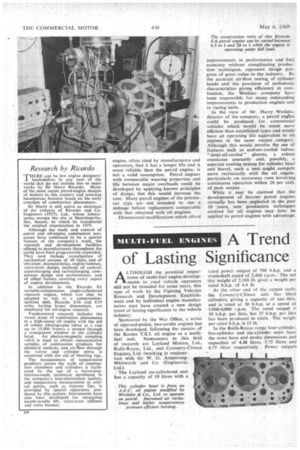MULTI-FUEL ENGINES
Page 122

Page 123

If you've noticed an error in this article please click here to report it so we can fix it.
A Trend of Lasting Significance
LTHOUGH the potential impor
tance of multi-fuel engine develop ments to road vehicle operators will not be revealed for some years, this type of work by the Fighting Vehicles Research and Development Establishment and by individual engine manufacturers may have created a new design trend of lasting significance to the vehicle industry. Sponsored by the War Office, a series of opposed-piston, two-stroke engines has been developed, following the success of the Rootes T.S.3. oil engine as a multifuel unit. Newcomers to this field of research are Leyland Motors, Ltd., Rolls-Royce. Ltd., and Coventry-Climax Engines, Ltd. (working in conjunction with Sir W. G. ArmstrongWhitworth and Co. (Engineers), Ltd.).
The Leyland six-cylindered unit has a capacity of 19 litres with a
rated power output of 700 b.h.p. and a crankshaft speed of 2,400 r.p.m.The net 'dry weight of 3,100 lb. gives a weight per rated b.h.p. of 4.4 lb.
' At the other end of the output scale, the Coventry-Climax unit has three cylinders, giving a capacity of one-litre, and is rated at 30 b.h.p. at a speed of 3,000-4,000 r.p.m. The rated output is 30 b.h.p. per litre, but 37 b.h.p. per litre has been produced in trials. The weigh; per rated b.h.p. is 15 lb.
In the Rolls-Royce range four-cylinder, five-cylinder and six-cylinder units have the same bore and stroke dimensions and capacities of 4.38 litres, 5.75 litres and 6.75 litres respectively. Power outputs of 160 b.h.p., 200 b.h.p. and 240 b.h.p., are obtained and weights per rated b.h.p. are 7 lb., 6.7 lb. and 6.5 lb.
The Leyland engine affords the highest power output per lb. that has yet been achieved by any oil engine manufacturer in the world, while the Coventry-Climax unit indicates the scope of this type of engine for vehicles normally propelled by petrol engines.
Although the ability of an engine to operate successfully on a:wide variety of fuels in quick succession is of doubtful commercial value, the development may be of particular interest in the export field because the power unit can be adjusted before it leaves the works, or by the distributors, to give the best results when running on the fuel that is most readily available M a particular locality.
Together with twostroke development is the
modification of conventional four-stroke units to operate on petrol and other nonstandard .fuels. Research work was undertaken recently in themodification of four-stroke engines to run on petrol with an octane rating. up to 80. Test results showed that comparatively simple modification of the cylinder head enabled a, .conventional typeof ,oil engine, running on petrol, to develop • an output 10 per cent, higher than that produced by fuel oil.
A. paPer presented at the F.V.R.D.E. conference in November last year by Mr. H. Weslake of the Weslake company, stated, that heating Of the charge air and high turbulence were necessary to give satisfactory operation on the lighter fuels, particularly under.the.adverSe conditions of.high speed and.low load. In the modification of, an A.E.C. cylinder head, air from the inlet valve is directed across the exhaust valve head by resetting the .masked .inlet valve, by changing theseat angle from 45 degrees to 30 degrees and by cutting a shallow channel between the . two valves. The compression ratio is raised .to 18 to 1 and turbillence is increased by contouring the head metal on one side of the inlet valve. .
An entirely new form of direct-injection system, designed for larger types of automotive unit and particularly suitable for multi-fuel applications, has been perfected recently by the Ricardo company. It is claimed that this new system has all the characteristics of clean running associated with the compressionswirl form, combined with the low fuel consumption and good coldstarting characteristics of the conventional direct-injection type. Particular attributes are unusually quiet running and the ability to operate on a wide range of fuels, including 80 octane petrol.




































































































































































































































































